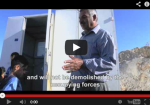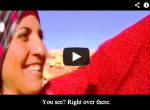
Palestinian and Israeli activists chant and beat drums during a demonstration near Susya in the South Hebron Hills on June 22, 2012. Israeli authorities have issued demolition orders against the entire Palestinian village of Susya, which is located near an Israeli settlement with the same name. Photo by RRB/Activestills.org
“Disconnected” is a video-blog project that brings the story of 10 years old Hadidja and her family who live in Susya, a Palestinian village in the South Hebron Hills, which is threatened with destruction.
It is not connected to electricity or water and, of course, is not connected to the internet. Susya residents live in caves and tin-shacks. A third world village that is located approximately 40 minutes ride from Jerusalem.
The Palestinian village of Susya has a history of suffering under the often-violent friction with extremists from the nearby Jewish settlement of the same name. The security forces rarely deal with the violence, and every now and then even support the extremists. Hamudy, a child from Palestinian Susya tells us about how he experiences these events.
West Bank Palestinians live under an institutionalized military regime of discrimination; they are not citizens, but subjects, and even in the realm of planning, construction and infrastructure investment they are being discriminated against. Palestinian Susya is one of the Palestinian villages that never gained recognition from the military administration [even though its present location results from the military expelling the residents from their original site]. Therefore the village is not connected to electricity or water, and has no sewage disposal system, let alone roads or pavement; its residents live in slums of abject poverty and neglect. Directly across from them, in the Jewish settlement of Susya, illegal construction [even by Israeli law] is whitewashed and enjoys broad government support: infrastructure, parks, educational institutions and environmental development. Such conditions naturally generate continual tension.
An extremist minority among the Susya settlers exacerbates the institutionalized discrimination by invading the Palestinians’ farmlands, and they often commit violent acts as well. The murder of a Susya settler by a Palestinian from the nearby village of Yata about ten years ago prompted the army to expell all the residents of Susya by force, backed by violence from some of the settler extremists. Under the cover of that deportation most of the caves that had served as homes for the Palestinians of Susya were destroyed. After a petition to the High Court, the Palestinian Susya residents were permitted to return to their farmlands. Because the caves had been demolished, they were forced to built tents and shanties. Demolition orders were issued for these new dwellings. As we can see in this video clip, settler violence creates a chain of successive problems beyond the immediate results of the violence: the takeover of agricultural land, expulsion from the land and all the related legal problems.
In this episode of Disconnected we follow ten-year-old Hamudy on his way to a regional school in the village of A-Twany. A-Twany is bigger than Susya and can provide better education, but is a twenty-minute drive by bus and cannot meet the needs of all of Susya’s children.
We then return to the harsh reality in Susya’s local school and its sorry condition. But, even under these circumstances, we will learn an optimistic lesson about democracy and the ability to choose to resist the military regime that seeks to impose its rules.
The village of Palestinian Susya has existed for centuries, long before the establishment of the settlement of Susya in 1983. There are documentary evidence of a settlement in the area dating back to 1830, and it is also marked on British mandatory maps from 1917. In 1948, the original population was augmented by Palestinian refugees who were expelled from the area of Ramat Arad and acquired land in the area. The residents of Khirebt Susya, now living nearby in isolated sites in the area north of the settlement, originally lived in the village Susya el Kadima (“old Susya”) in the area of the ancient synagogue of Susya, an area that was an inhabited village up until the 1980s. Their ownership of the land is has been legally established and attorney Plea Albeck, one of the architects of Israel’s project to seize control over lands in the West Bank, wrote in a legal opinion from 1982 that the land was privately owned. This Civil Administration informed the inhabitants of Palestinian Susya of its intention to soon carry out six demolition orders that were issued in the 1990s and in 2001. These orders apply to most of the area of Susya and relate to some fifty buildings, including residential buildings, animal pens, solar energy panels and water cisterns (Palestinian Susya, like most of the villages in the south Hebron hills, is not connected to the electricity and water grid). These orders add to numerous similar orders that were issued to Susya recently. These Demolition orders have been issued despite the fact that the land in question is a private land of inhabitants of Palestinian Susya disregarding the absence of a master plan for Susya which denies the residents of Palestinian Susya any possibility of obtaining building permits from the Civil Administration. If these demolitions are carried out, hundreds of residents of Palestinian Susya will be cast out into the burning desert sun for the fifth time in twenty five years. The Israeli public does not know the local history and so we are presenting this guest article which details the history of the village.
Read more:
- 1,500 Palestinians face expulsion to make way for IDF ‘Firing Zone 918′
- Susya – a view from within
- The poor man’s lamb and twisted facts: Replay to Smoritz from “regavim” on the issue of Susya
- To show solidarity with Susya
- Don’t stop the fight for Susya
- David Shulman’s Testimony from the Protest in Susya
- The origin of the expulsion – A Brief history of Palestinian Susya (Guest article)
- Stop the Destruction of Susya: Newsletter for the parashat “Korach”
- Join the protest Vigil: No to the Demolition of Susya
- A Promise to Fight until the Very End
- South Hebron Hills: A military regime for none or for all
- Please support Palestinian residents of Susya vs. Regavim and the Israeli Government
Write to the President and prime Minister:
Email: Israel’s Prime Minister Benjamin Netanyahu : pmo.heb@it.pmo.gov.il ; media@pmo.gov.il
Email: President of the state of Israel Mr. Shimon Peres: public@president.gov.il
Fax: +972-2-5664838 ; +972-2-5887225 (You can send via free fax)
Subject: Please use your power to prevent the injustice of wiping out the entire Palestinian village of Susya
Dear Mr. President/Prime Minister
Please use your power to prevent the injustice of wiping out the entire Palestinian village of Susya, whose only offense us building for its own survival. Only because the villagers were expelled from the original location by the IDF have they been forced to build their flimsy homes on their farmland.
Background: The Palestinian village Susya is located in South Mt. Hebron, one of the poorest, disempowered places in the entire West Bank. The village consists mainly of tents, with no electricity, water or sewage infrastructure, and barely subsists on seasonal agriculture.
Palestinian Susya is located on its residents’ farmland, which has no building permits. It was not built because the Palestinians are flouting the law, but because they were driven from their original place of residence nearby, which they also owned. In 19896 the area was declared an archaeological site because remains of an ancient Hebrew settlement were discovered there. The Palestinians, who lived in caves in the area, were expelled from the area without being provided with an alternative place to live – so they moved to other nearby caves on their adjacent farmland.
In 2001 they were all expelled again, this time from their farmland as well, and the army destroyed the caves in which they had lived. The reason: a settler from nearby Susya (the settlement) was murdered. The killer they apprehended was from the town of Yata, but that didn’t stop the army from destroying all of Susya. The idea of collective punishment – of punishing an entire village for the offenses of one person – is distorted, destructive and unlawful, but in the case of Susya the punishment was meted out to a village that had nothing to do with the murderer, making it even more distant from logic and ethical behavior.
The same year, after a petition to the Supreme Court, the judiciary ruled that the residents must be permitted to return to their lands. But since the caves had been destroyed, the Susya residents were forced to build tin shanties and tents just to survive. The planning apparatus in the area, controlled my military officers, is unprepared to recognize the special circumstances and approve construction there. Demolition orders have been issued for the structures in the village. Recently the extremist organization Regavim petitioned the court to expedite the demolitions, and the entire village is in peril.
On 31 January an essential session of the Supreme Court will take place regarding the future of the village. We must spread word of the injustice and desecration of God’s name at risk of taking place in our name. We cannot let our country act toward the stranger in our midst in such a way that it forgets our heritage; that forgets we were slaves in Egypt. We have been commanded to remember.
Remember that which was said in Deuteronomy 23:17 about the stranger and where he lives: “With you shall he swell, among you, in the place that he chooses, in one of your gates; you shall not afflict him.”






1 comment
Comments feed for this article
May 14, 2013 at 2:22 pm
Letters Urgently Needed to Save Susya: Shavuot Thoughts on Being Torah | Rabbis for Human Rights
[…] To refresh your memory about Susya, you may wish to see the lastest chapters our Susya videoblog by award winning filmmaker Ibtisam Mara’ana and/or read more background. […]